Informatica MDM Tutorial for Beginners
Effective data handling is increasingly important as businesses rely on it as a decision-making resource. Introducing Informatica MDM, the industry-leading platform that gives businesses insight and control over the data they’ve been missing out on.
Informatica MDM is ideal for businesses that want to maximize their data by enabling users to quickly access and integrate data and providing data governance and quality tools.
Learn more with Informatica MDM tutorials today!
MDM Informatica

MDM Informatica is an Enterprise Data Management (EDM) software with MDM and Data Governance capabilities. Organizations can utilize it to guarantee data accuracy and consistency.
MDM Informatica allows users to develop, manage, and maintain a single, consistent view of their data. This facilitates enterprise understanding and Decision-Making.
Controlling Access and Enforcing Data policies across the company improves data quality while reducing risks.
The MDM Hub creates, stores and manages master data records. It also offers data validation, auditing, Data Versioning and Workflow solutions.
MDM Informatica’s Scalability makes it suitable for both large and small enterprises alike, offering flexibility to adjust to each organization’s specific requirements.
With multiple databases and applications available both on-premise or in the cloud, this solution can be utilized wherever data resides.
Informatica MDM Complete Form
Informatica Master Data Management (MDM) helps companies centralize their data. It collects business information from relational databases, flat files, and online services.

These features enable enterprises to manage, preserve, and update master data across their organization – guaranteeing accuracy and consistency across all platforms.
Informatica MDM also assists companies in creating a single source of truth for their data, which makes data management much simpler for enterprises. It simplifies Data Integration with external systems and guarantees data quality and consistency across the firm.
Data profiling, cleansing, matching and other features are available. Furthermore, predictive data mining and Visualization Data Analytics as well as reporting are included.
Data management solutions from Replicant provide a centralized source of truth for business data, guaranteeing data accuracy and consistency across all platforms.
It offers data cleansing, matching, governance, and master data management as well as powerful analytics, reporting tools to assist firms in completing their corporate records.
Informatica MDM Means
Master data management encompasses all phases of data creation, processing, transformation, consolidation and retirement.
Some see data management as the extension of essential Data Management to encompass other entities’ records; others, it means combining different solutions into one central platform; while still others associate it with enterprise Informatica applications.
Informatica MDM Architecture

Centralizes customer, product, and asset data across an organization while Integrating Enterprise Data Analytics and coordination.
The Informatica MDM architecture comprises the repository, services, tools, and applications necessary for success.
MDM Repository
Stores customer, product and asset information centrally
All Informatica MDM platform components use this repository to store customer and product data, business rules, and policies.
MDM Services
MDM services manage, process, analyse customer and product data by cleaning, transforming, integrating and synchronizing it.
MDM Tools
Tools used for data quality assessment analyse and improve existing models, create reports and dashboards, as well as manage customer and product data.
MDM Applications
MDM applications create, organize and refine these databases by creating hierarchies, attributes, profiles for customers and products respectively.
The MDM portal consists of an integration layer, security layer, integration services, analytics and reporting functions as well as data governance services.
The MDM portal controls user access to MDM to Connect Data and Applications.
MDM integration layer links MDM data with other systems and applications.
MDM provides security by enforcing access controls on data and applications.
Analytics and reporting from MDM generate reports and dashboards for management oversight.
MDM Data Governance guarantees data accuracy, completeness and consistency.
Cleanse functions in Informatica MDM
Cleanse functions are user-defined SQL or Informatica MDM Server procedures that determine whether data should be removed from the Hub and, if so, how.
Enforcing cleanse functions in Informatica MDM helps to disable these processes so users cannot override the cleanse and validation processes.
Master data, an organization’s most significant and used data, should be managed for accuracy, consistency and integrity.
Informatica MDM purges data to ensure accuracy and consistency. These functions eliminate duplicates, normalize values, and validate data for validity.
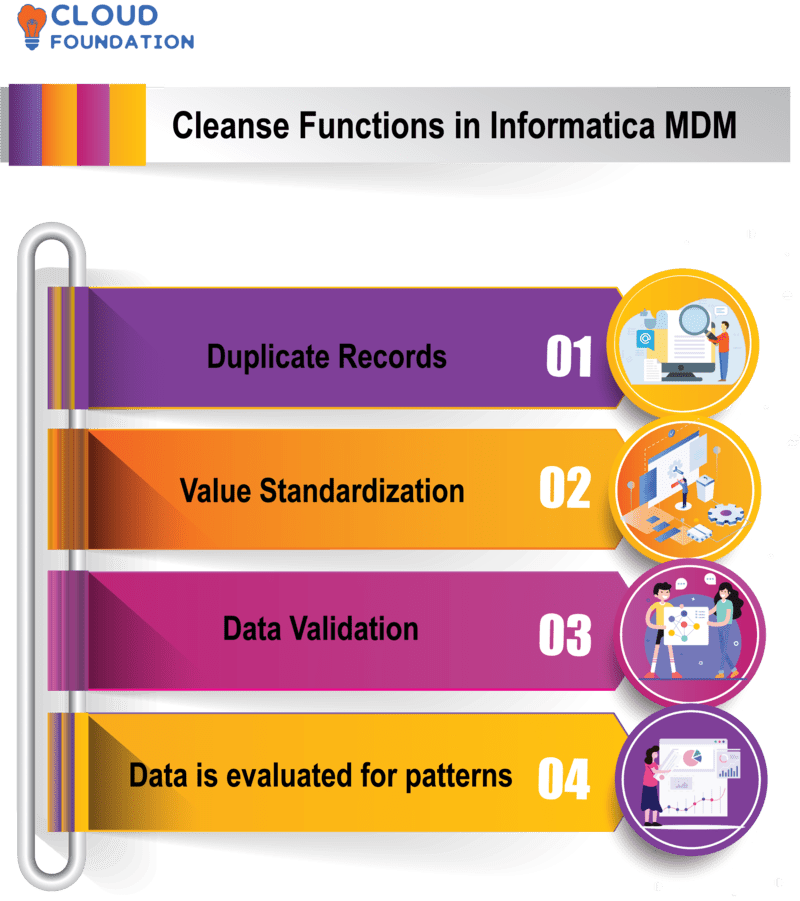
Duplicate records should be identified first during cleansing. Comparing data across sources and formats helps with this; two records with the same name but different addresses should be flagged as duplicates, so the master data can be cleansed of these unwanted records.
Value standardization should occur after cleansing. Data is compared against standards, and two records with distinct product names should use the standard name. This ensures master data consistency.
Data validation Here, data is checked against regulations and invalid email addresses should be marked as errors so they can be addressed and either corrected or removed.
Finally, data is evaluated for patterns. This helps firms identify ways to optimize operations and enhance Data Quality. These functions guarantee businesses have accurate master data at all times.
Informatica Cloud MDM
Informatica cloud MDM maximizes data value for enterprises. The solution provides comprehensive functionality to manage master data in a unified, secure, and dependable environment.
It makes master data creation, storage and management across systems, domains and geographies much simpler. It enhances master data accuracy, visibility and control for improved efficiency and effectiveness.
The Informatica cloud platform securely and reliably manages master data while MDM software enables companies to construct and maintain master data sets.

It enables companies to quickly and securely create, manage, and access master data while increasing accuracy and consistency of processing.
Companies can leverage master data in various ways. Furthermore, the system enables enterprises to securely maintain and exchange master data with external partners and customers.
It efficiently creates and manages master data in an organized, secure, and reliable environment. Furthermore, the solution integrates master data with other applications and systems.
Informatica MDM Match and Merge
Match and merge operations in Informatica MDM allow data from multiple sources to be combined. With the Informatica MDM Hub, a match is defined by an expression and scope, returning all records that meet that condition within a specified area.
For a merge, the match condition dictates what data to include. The scope is an object that holds the match result.

Informatica MDM Match and Merge automates Customer Data Management for large enterprises. Through data cleansing/matching, entity resolution, audit and governance technologies, firms are able to maintain an accurate and up-to-date customer view.
This solution consolidates and merges customer records from multiple sources, utilizing Informatica’s superior data management capabilities for a comprehensive, accurate customer view.
Entity resolution, data cleansing and audit and governance solutions offer companies a way to protect consumer data integrity.
Informatica MDM Match and Merge Benefits
Organizations Benefit from Informatica MDM Match and Merge:
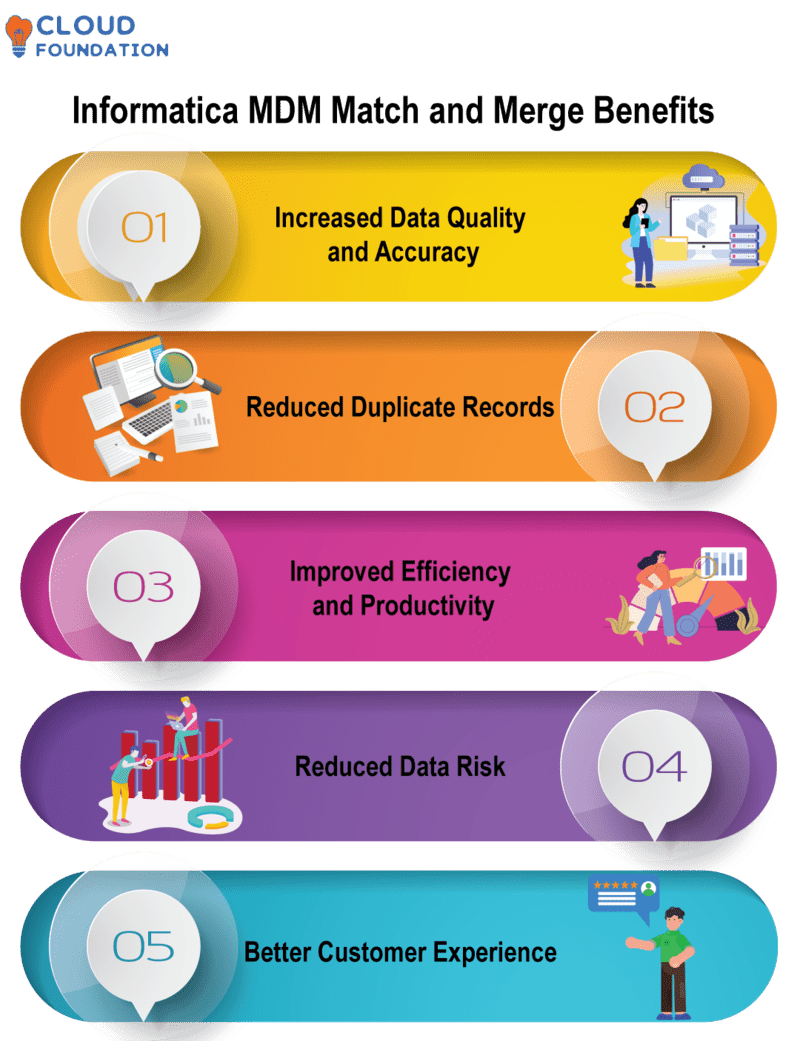
Enhancing Data Quality and Accuracy
This solution assists firms in maintaining accurate, up-to-date customer data by integrating information from multiple sources and verifying it against industry standards.
Improved Efficiency and Productivity
The solution simplifies data management, enabling companies to quickly and precisely match client records. This makes client data management faster and more efficient.
Reduced Duplicate Records
The solution helps enterprises eliminate duplicate customer records by merging client data from various sources and validating it against standards. This eliminates duplicate records by eliminating incomplete contact information.
Reduced Risk
Informatica MDM Match and Merge guarantees client data is accurate and up-to-date to help protect against data breaches.
Better Customer Experience
The solution helps firms comprehend and cater to their customers by providing a detailed picture of them.
Informatica MDM Match and Merge allows companies to efficiently manage vast customer data sets. Data cleansing, matching, entity resolution, audit and governance technologies give businesses a precise and up-to-date customer perspective.
The solution’s enhanced features can reduce data breaches, enhance customer service, and enhance efficiency and productivity.
Segment matching in Informatica MDM

Informatica MDM Hub offers a segmentation and matching engine to Detect and Combine Records that contain duplicate values in certain fields.
In the Informatica MDM Hub console, users have access to a wealth of schema and data level matching options such as field, value, and exact match comparisons.
Additionally, custom SQL can be utilized for matching purposes. Transformers are objects in the Hub Store that allow Data Transformation or modification before it is stored there. Within Informatica MDM Hub, transformers are employed for data cleansing and enhancements.
Informatica MDM Hub provides a set of built-in transformers to simplify data cleansing and enhancement tasks, such as stripping HTML tags from text data or replacing null values with default values.
Match Rules in Informatica MDM
Match rules determine how much and what content of source data is utilized during transformation.
Match rules come in two distinct varieties:

Content Match Rules
Used to determine which content will be utilized in matching.
Properties Match Rules
Used to select properties used for matching.
Informatica MDM uses a combination of regular expressions and string matches to determine whether any fields in a record should be passed along to the following rule in its rule set.
For instance, if the initial rule in a rule set is a string match, that record will be passed onto the rule set if its data matches up with what was specified by the string match pattern.
If the initial rule in a rule set is a condition rule, then the record will be passed to that rule set if no other matching rules exist.
If the last rule in a rule set is a match rule, the record will be passed to that rule set if any rules in it are fulfilled.
When adding a rule set to an existing rule group, make sure it is listed as a conditional rule set within the ruling group.
Informatica MDM Tool
This platform unifies consumer, product, and other data across multiple platforms. It handles relational databases, flat files, online services, and cloud applications alike.
Informatica MDM can cleanse and standardize data, create a single view of customers and goods, as well as offer real-time insights into customer and product interactions.
Informatica MDM reduces data chaos, enhances operational efficiency, and ensures master data accuracy and consistency.
It creates a single version of customer, product and other reference data so all organization systems and apps use the same accurate and up-to-date info.
Informatica MDM provides data governance capabilities. It enables companies to set and enforce master data accuracy and consistency standards.
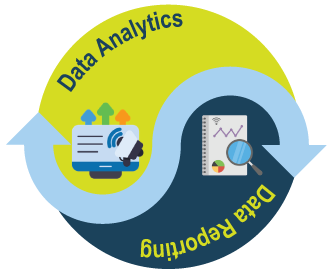
Informatica MDM offers powerful Data analytics and reporting, enabling users to create comprehensive customer and product interaction reports and dashboards.
This helps companies identify opportunities while streamlining master data management processes. Informatica MDM maximizes master data value.
Its advanced analytics and reporting enable companies to gain insight into customer and product interactions, while offering an integrated data governance framework to guarantee master data accuracy and consistency.
MDM Hub Informatica
Informatica MDM Hub leverages a server to provide resources, such as Web pages and applications, on demand.
The Informatica MDM Hub Server Configuration Guide and Administrator Guide provide instructions for setting up the server environment.
The HTTP protocol enables applications and devices to connect with the Informatica MDM Hub through a browser and URL. SOAP over HTTP protocol converts a SOAP message into an HTTP request.
Both protocols rely on HTTP messages to transmit data. When sending a message to the Informatica MDM Hub, it must include its protocol and hostname as well as request path and message parameters.
When applying the SOAP over HTTP protocol to Informatica MDM Hub, an HTTP request is sent. In addition, XML over HTTP can also be utilized.
The XML over HTTP protocol converts an XML message into an HTTP request. Informatica MDM Hub offers both RPC and SOAP-based web services for convenience.
However, data can be transformed into formats like XML, JSON and CSV for use by remote procedure calls.
Informatica MDM Hub provides RPC calls, which are similar to SOAP calls in functionality but utilize the HTTP protocol for transmitting SOAP messages over HTTP.
Delta detection in Informatica MDM
Delta detection within Informatica MDM helps ensure data integrity. It detects and stores only master data changes while preserving existing information.
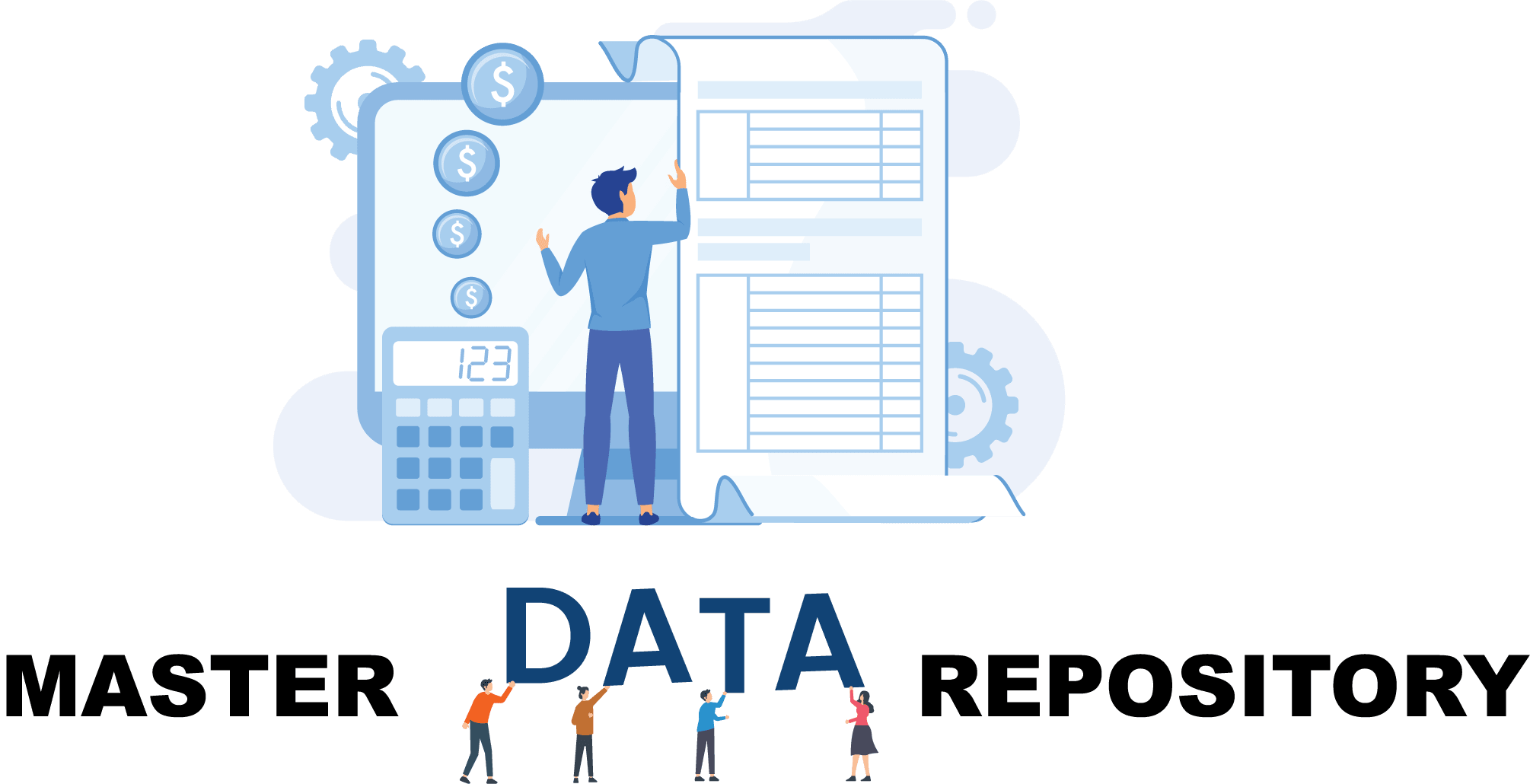
Delta detection detects new, altered, and deleted data records to reduce processing and storage requirements. It also Updates and Rectifies the Master Data Repository.
Change data capture is the foundation of Informatica MDM delta detection. This process stores master data changes in a separate location and logs all source data modifications.
Logging master data updates ensures the accuracy and current state of master data in a central repository.
Delta detection speeds up Data Processing by keeping only master data updates. This enables data to be updated more frequently and accurately.
Informatica MDM also has data accuracy features. Construct rules to validate data and filter out invalid records, while data masking protects sensitive information.
They include creating a “data governance” structure to keep data current and accurate, as well as setting up a “data quality monitor” to detect mistakes or anomalies.
Data processing and storage can be simplified, keeping the master data repository up-to-date and accurate.
Hub State Indicator in Informatica MDM
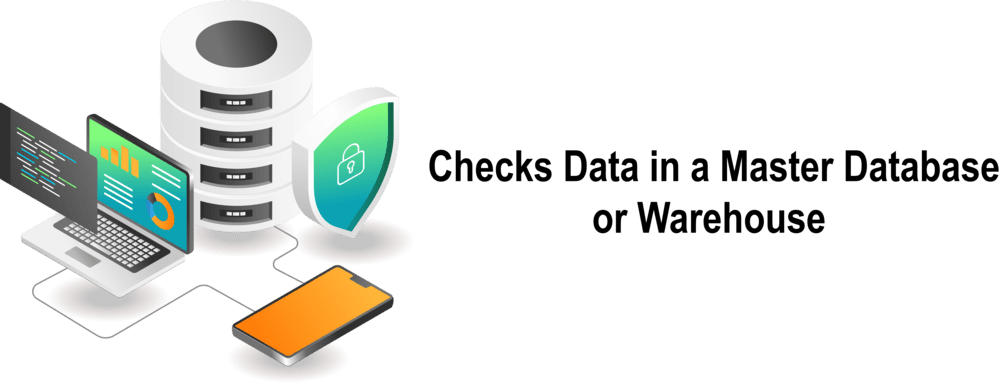
Informatica MDM’s Hub Status Indicator assists businesses in keeping their data up-to-date and accurate. It automatically checks data in a master database or warehouse and alerts users of changes. This ensures accurate, up-to-date, secure information is maintained.
Data accuracy, security, and timely updates are ensured with a single version of the truth.
The indication helps organizations safeguard and keep their data accurate.
The consolidation indicator in informatica mdm continuously tracks master database or data warehouse data to alert users of changes and enable them to take action. It also helps companies keep their information up to date by continuously monitoring their databases.
No matter how many databases or Data Warehouses a company utilizes, this guarantees accurate and Secure Data Integration.
Informatica MDM offers a suite of data management tools, such as the Hub State Indicator. Other features include data replication, security, integration and governance so businesses can protect and enhance their data with these options.
Businesses can ensure data accuracy and safety by maintaining a master database or data warehouse.
Informatica MDM Tutorials
The Informatica MDM Tutorial is a web-based resource to learn more about the Informatica MDM solution. It covers topics like MDM Console, Hub, data loading, master data management, and more in complete detail. It includes instructions and examples so users can make the most out of their MDM experience.
When learning the details of MDM, CloudFoundation Online Training Platform is the best resource to learn Informatica MDM Course.
The CloudFoundation Online Training Platform provides the most comprehensive coverage of the Informatica MDM Course.
This Informatica MDM course gives students an in-depth understanding of master data management principles and practices and the technology that supports them. It also gives them the practical expertise to apply these concepts in real-world projects.
This cloud-based eLearning platform provides an engaging and immersive learning experience for individuals interested in Informatica MDM Certification.
Interview Questions on MDM Informatica
If you want to pursue a career in Master Data Management (MDM) Informatica, be prepared for various Informatica MDM Interview Questions. As this field requires highly specialized expertise, it’s essential that you showcase your abilities and knowledge to potential employers.

How should you model MDM Informatica data?
Data model creation is required for this question. Discuss how you analyse requirements, design, and test a data model. Highlight each step’s significance in the process.
How does MDM Informatica ensure data security?
Explain how to validate data before entering it, utilize data quality tools, and audit the system to guarantee data integrity.
MDM Informatica Data Accuracy: How can You Achieve It?
You must demonstrate your data accuracy and maintenance expertise for this question. Data security is of the utmost importance with MDM Informatica; discuss your data security methods, such as encryption, user roles and permissions, and monitoring user access.
MDM Informatica Troubleshooting: What Should You Do?
For this question, you will need to demonstrate your problem-solving and troubleshooting abilities. Outline the steps in your troubleshooting process, such as discovering the cause, researching possible solutions, testing them out and validating results.
Prepare for your interview by researching the company and role, then practicing answering the above questions. Best of luck!

Divya
Author
Hello all! I am gonna pop you with the information that will make your life easier.



